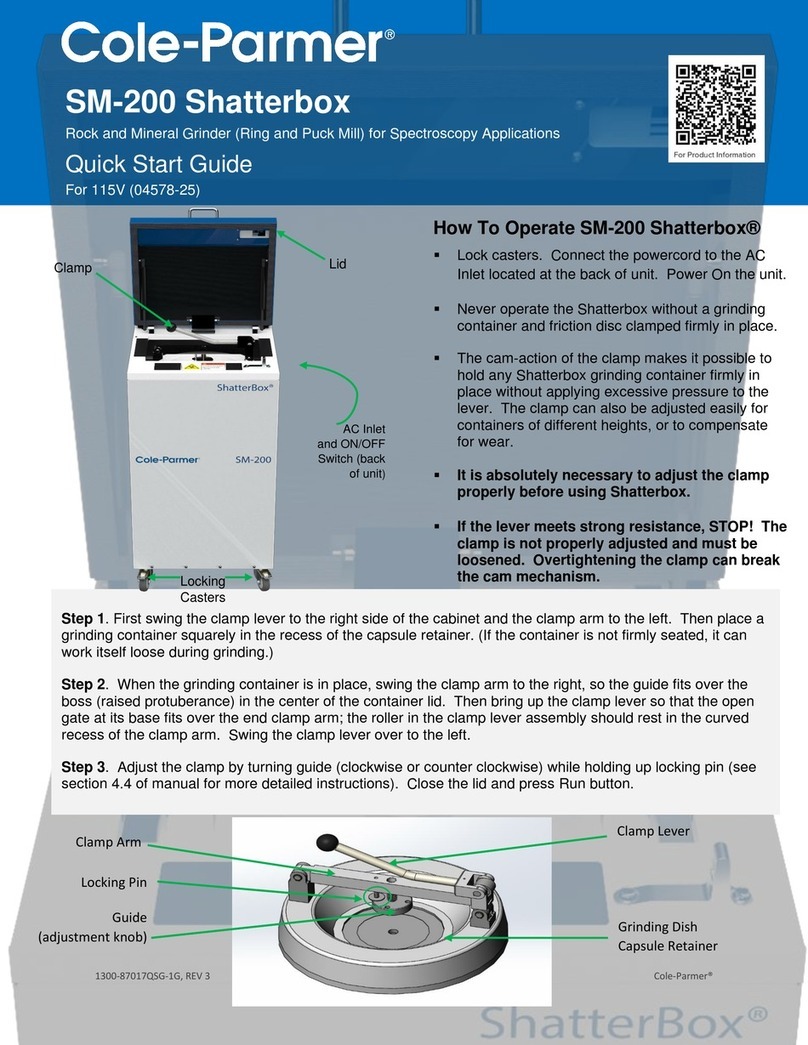SM-300 Shatterbox
1300-87017-1M, REV 5 Cole-Parmer® Page 6 of 20
3.0 UNPACKING
The SM-200 Shatterbox mechanism and its cabinet are shipped assembled, and carefully
packed to avoid damage during shipping. Any visible damage to the shipping container should
immediately be reported to the carrier. If there is no visible damage, remove all packing
documents from the exterior of the box, and after completion of your inspection, file in your
records.
Before unpacking the SM-200 Shatterbox, place the shipping carton upright and as close as
possible to the mill intended location. Open the top of the shipping box. Remove the top and
body of the carton. Note that if the tape holding the carton’s bottom piece together is slit on
one side, that flap can be folded down and the Shatterbox rolled off after unlocking the casters.
A plug-in line cord, an extra set of 51793 drive belts, an extra set of fuses, and a 31688 Friction
Disc are included with your new Shatterbox. One Friction Disc (a circle of thin rubber matting)
should always be kept in the recess off the capsule container, to cushion the grinding container,
reduce the noise of the grinding, and prevent unnecessary and rapid wear of the clamp and
capsule retainer.
Move the mill to the location where it is likely to stay, lock the casters, and open the lid. Please
note that the Shatterbox should always be installed and operated on a level surface. Check the
power switch, which is on the back of the cabinet, next to the electrical inlet (Diagram C, Item
48); this switch should be in the off position (the 0 should be pushed in) when the power cord is
first attached. Look for any hidden damage that may have occurred during shipping.
The SM-200 Shatterbox comes fully assembled. However, before plugging the Shatterbox in
and using the controls for the very first time, first inspect the drive mechanism to make sure
it is properly linked and aligned. The Shatterbox was tested before shipment, but there are
four flexible belts connecting two drive arms, one on the motor and one on the capsule
retainer. The belts can become dislodged during shipping. If the Shatterbox is run with the
drive mechanism uncoupled or misaligned, damage can result.
To inspect the drive mechanism, remove the access panel on the back of the case. (Note that in
general this panel should not be removed without unplugging the power cord.) Check the belt
linkage between the arm on the motor and the arm on the rotating funnel on the bottom of the
capsule assembly. The two arms should be parallel and unbent, connected by four belts (O-
rings) in a diamond pattern that overlaps at the corners (Diagram B, item 34). (The coupling arm
is attached to the top of the motor shaft. The eccentric arm is attached to the bottom of the
rotating funnel.) Spin the arms by hand; the motor arm and the funnel arm should rotate
together smoothly.
If the drive belts have come off, replace them as pictured in Diagram B: in a diamond pattern,
two belts up and two belts down. Spin the arms by hand.





























